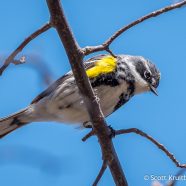Black-throated Green Warbler (Setophaga virens)
This is about the best look I have had at a Black-throated Green Warbler (Setophaga virens) so far this spring, only spotting a few individuals. That is probably because I have not spent much time around conifers in the last couple of weeks. The Mid-Atlantic radar is exploding tonight as migrants push north on some cooperative winds – get out there tomorrow morning and see what you can find! Scott Kruitbosch Conservation & Outreach Coordinator
Read MoreCommon Yellowthroat (Geothlypis trichas)
Some of our more common breeding songbirds have returned to the Northeast and are already setting up territories. The Common Yellowthroat (Geothlypis trichas) is one such species, and RTPI Affiliate Sean Graesser captured the character of an adult male in this wonderful piece for his Audubon series. Photographed for the Meet Your Neighbours global biodiversity project in Connecticut while on assignment for The Roger Tory Peterson Institute of Natural History.
Read MoreYellow-rumped Warbler
Here are a couple more stunning Yellow-rumped Warbler photos while they are looking so fantastic in their spring shades – and right before all the leaves pop out. They’ll be heading out soon as a greater diversity of warblers arrive in our backyards. I did see one unique Yellow-rumped Warbler yesterday that I will feature in an upcoming post… Scott Kruitbosch Conservation & Outreach Coordinator
Read MoreWorm-eating Warbler (Helmitheros vermivorum)
I was thrilled to find and then get great views of this Worm-eating Warbler (Helmitheros vermivorum) singing and feeding earlier today. I first heard its insect-like trill of a song from along a steep, rocky slope in the forest featuring a lot of vegetation in the understory – precisely what they want for the breeding season. We in the Northeast are at the northern edge of their range, and finding the uncommon birds can be difficult. Worm-eating Warbler populations are said to be stable, but they certainly do decline and increase in certain regions depending on local conditions....
Read MoreAmerican Redstart
This is as good of a photo that I could get this morning of the adult male American Redstart (Setophaga ruticilla) seen below, and clearly I need to do better! The conditions were brutal with continued rain and some fog moving in on a very dark day, making the bird stand out even more against the drab surroundings. It was foraging and catching quite a bit while showing those bright wings and that flashy tail to help scare up insects. The weather has been uncooperative for birds as the first few days of the May migratory flight has been difficult with variable winds and precipitation making...
Read More








